Behringer DSP2024P User Manual
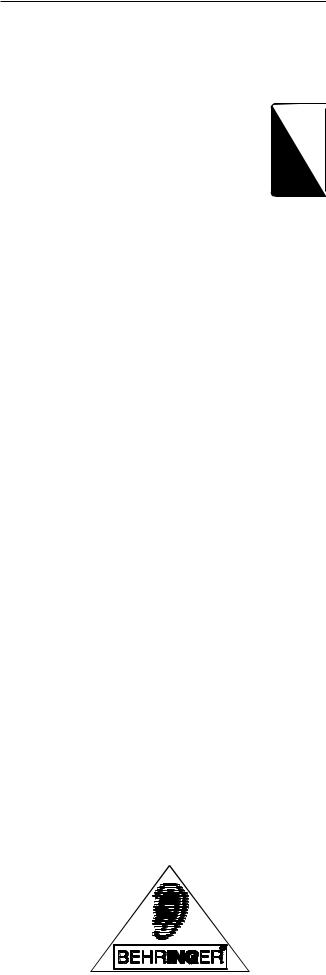
VIRTUALIZER® PRO DSP2024P
User’s Manual
Version 1.1 February 2002
ENGLISH
www.behringer.com

VIRTUALIZER PRO DSP2024P
SAFETY INSTRUCTIONS
CAUTION: To reduce the risk of electric shock, do not remove the cover (or back). No user serviceable parts inside; refer servicing to qualified personnel.
WARNING: To reduce the risk of fire or electric shock, do not expose this appliance to rain or moisture.
This symbol, wherever it appears, alerts you to the presence of uninsulated dangerous voltage inside the enclosure—voltage that may be sufficient to constitute a risk of shock.
This symbol, wherever it appears, alerts you to important operating and maintenance instructions in the accompanying literature. Read the manual.
DETAILED SAFETY INSTRUCTIONS:
All the safety and operation instructions should be read before the appliance is operated.
Retain Instructions:
The safety and operating instructions should be retained for future reference.
Heed Warnings:
All warnings on the appliance and in the operating instructions should be adhered to.
Follow instructions:
All operation and user instructions should be followed.
Water and Moisture:
The appliance should not be used near water (e.g. near a bathtub, washbowl, kitchen sink, laundry tub, in a wet basement, or near a swimming pool etc.).
Ventilation:
The appliance should be situated so that its location or position does not interfere with its proper ventilation. For example, the appliance should not be situated on a bed, sofa, rug, or similar surface that may block the ventilation openings, or placed in a built-in installation, such as a bookcase or cabinet that may impede the flow of air through the ventilation openings.
Heat:
The appliance should be situated away from heat sources such as radiators, heat registers, stoves, or other appliances (including amplifiers) that produce heat.
Power Source:
The appliance should be connected to a power supply only of the type described in the operating instructions or as marked on the appliance.
Grounding or Polarization:
Precautions should be taken so that the grounding or polarization means of an appliance is not defeated.
Power-Cord Protection:
Power supply cords should be routed so that they are not likely to be walked on or pinched by items placed upon or against them, paying particular attention to cords and plugs, convenience receptacles and the point where they exit from the appliance.
Cleaning:
The appliance should be cleaned only as recommended by the manufacturer.
Non-use Periods:
The power cord of the appliance should be unplugged from the outlet when left unused for a long period of time.
Debris and Liquid Entry:
Care should be taken that debris and/or liquids do not enter the enclosure through openings.
Damage Requiring Service:
The appliance should be serviced by qualified service personnel when:
-The power supply cord or the plug has been damaged; or
-Debris or liquid has entered the appliance; or
-The appliance has been exposed to rain; or
-The appliance does not appear to operate normally or exhibits a marked change in performance; or
-The appliance has been dropped, or the enclosure damaged.
Servicing:
The user should not attempt to service the appliance beyond that which is described in the operating instructions. All other servicing should be referred to qualified service personnel.
2

VIRTUALIZER PRO DSP2024P
FOREWORD
Dear Customer,
Welcome to the team of VIRTUALIZER PRO users and thank you for demonstrating your faith in us by purchasing the DSP2024P.
Writing this foreword to you is an extremely pleasant task. After several months of intensive brainstorming and the subsequent realization of their ideas, our engineers finally achieved an ambitious goal: considerable improvement of an excellent piece of equipment. The VIRTUALIZER has been regarded as standard equipment for countless studios and P.A. distributors for quite a while now. As with any new product, the development of this new VIRTUALIZER PRO also meant a great deal of responsibility. Throughout the entire planning and development phases, we kept you—the discerning end-user and musician, your requirements and your requests at the focal point of our considerations. Meeting your professional expectations required a lot of effort and more than a few night shifts, but this is exactly the kind of challenge that keeps us alive and kicking. Developing a new product always brings a large number of people together, and it’s a great feeling when all involved can take pride in the results.
It is an important part of our philosophy to share our gratification with you, since you’re the most important member of the BEHRINGER team. With your highly competent suggestions for new products, you’ve contributed immensely to the development and success of our company. In return, we bring you uncompromising quality (manufactured under ISO9000 certified management system) as well as excellent technical and audio specifications, at an extremely favorable price. We hope that this will enable you to fully unfold your creativity without being hampered by budget constraints.
We are often asked how we manage to produce such high-grade devices at such unbelievably low prices. The answer is quite simple: it’s you, our customers! Lots of satisfied customers means large sales volumes, which in turn enables us to reduce production and logistics expenses. We believe it’s only fair to pass this benefit back to you—after all, your success is our success!
I would like to thank everyone who helped make our new VIRTUALIZER PRO project possible and successful. Each of those people made very personal contributions, from our engineers and designers to our numerous staff members and finally to you as a BEHRINGER user.
My friends, it’s been worth the trouble!
Thank you very much,
Uli Behringer
3
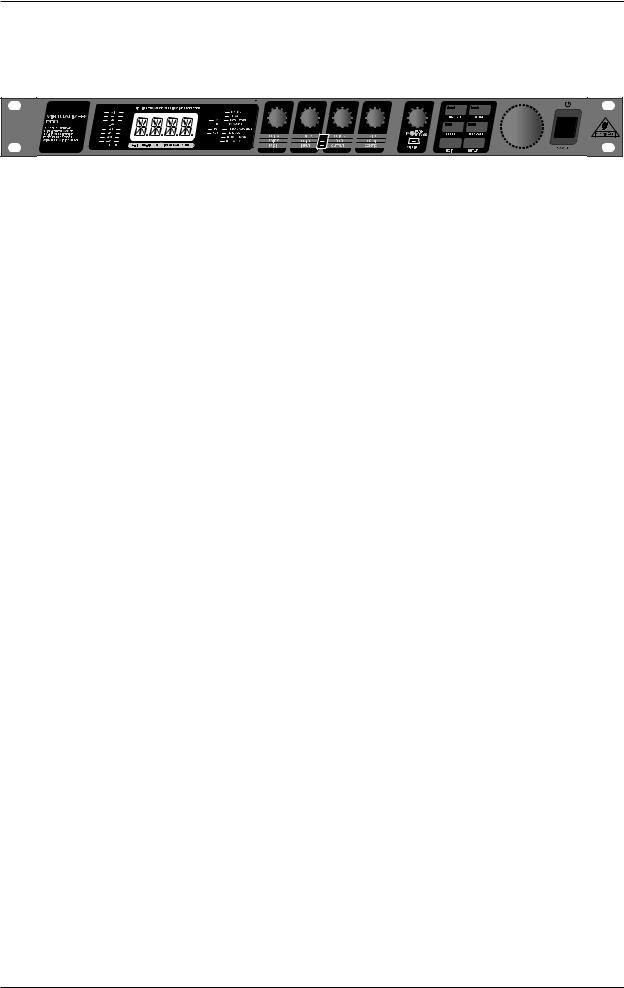
VIRTUALIZER PRO DSP2024P
VIRTUALIZER® PRO
High-Performance 24-Bit Multi-Engine Effects Processor
71 breathtaking new algorithms, most in true stereo
Wave-adaptive VIRTUAL ROOM reverb algorithms for ultra-natural reverb and delay
Awesome modulation, dynamic, psychoacoustic and EQ algorithms
Innovative amp simulation, distortion and special effects
11 effect combinations with selectable serial/parallel configuration
Up to 7 adjustable parameters plus HI and LO EQ per effect
High-resolution 24-bit A/D and D/A converters with 64/128-times oversampling
True stereo processing for realistic channel separation in stereo image
24-bit internal signal processing, professional 46 kHz sample rate
100 factory presets plus 100 user memory locations
Extensive MIDI implementation
Precise 8-segment LED level meters
Internal power supply for professional applications
Servo-balanced XLR and 1/4" TRS inputs and outputs
Manufactured under ISO9000 certified management system
DSP2024P
4

VIRTUALIZER PRO DSP2024P
TABLE OF CONTENTS
1. INTRODUCTION..................................................................................................................... |
6 |
|
1.1 |
The concept .................................................................................................................................... |
6 |
1.2 |
Before you get started ..................................................................................................................... |
7 |
1.3 |
Control elements ............................................................................................................................. |
7 |
2. EFFECTS ALGORITHMS ..................................................................................................... |
10 |
|
2.1 |
Reverb algorithms .......................................................................................................................... |
11 |
2.2 |
Delay algorithms ............................................................................................................................ |
11 |
2.3 |
Modulation and Pitch Shifter effects .............................................................................................. |
12 |
2.4 |
Dynamic effects ............................................................................................................................ |
13 |
2.5 |
Psycho-acoustic effects ................................................................................................................ |
14 |
2.6 |
Filter/EQ effects ............................................................................................................................ |
15 |
2.7 |
Distortion effects and amp simulations .......................................................................................... |
16 |
2.8 |
Special effects .............................................................................................................................. |
17 |
2.9 |
Effects algorithm combinations (multi-effects programs) ................................................................ |
18 |
3. OPERATION .......................................................................................................................... |
20 |
||
3.1 |
Effects structure............................................................................................................................ |
20 |
|
3.2 |
Calling up presets ......................................................................................................................... |
23 |
|
3.3 |
Editing programs (edit mode) ........................................................................................................ |
23 |
|
3.4 |
Storing programs ........................................................................................................................... |
23 |
|
3.5 |
Comparing an edited preset with the corresponding factory preset (COMPARE function)............... |
24 |
|
3.6 |
SETUP mode ................................................................................................................................ |
24 |
|
|
3.6.1 |
MIDI control ........................................................................................................................ |
24 |
|
3.6.2 |
INPUT mode ....................................................................................................................... |
25 |
|
3.6.3 |
OUTPUT mode.................................................................................................................... |
25 |
|
3.6.4 Dual engine configuration (CONFIG) .................................................................................... |
25 |
|
3.7 |
Restoring the factory presets ........................................................................................................ |
25 |
|
4. APPLICATIONS ..................................................................................................................... |
26 |
|
4.1 |
Level setting .................................................................................................................................. |
26 |
4.2 |
Using the VIRTUALIZER PRO in the aux bus ................................................................................ |
26 |
4.3 |
Using the VIRTUALIZER PRO in the insert path ............................................................................ |
27 |
4.4 |
Using the VIRTUALIZER PRO as an effects device for instruments ............................................... |
27 |
4.5 |
Using the VIRTUALIZER PRO in a MIDI setup............................................................................... |
29 |
5. |
MIDI FUNCTIONS OF THE DSP2024P ............................................................................... |
29 |
|
|
5.1 |
Saving data via MIDI ...................................................................................................................... |
29 |
6. |
INSTALLATION ..................................................................................................................... |
30 |
|
|
6.1 |
Mains connection .......................................................................................................................... |
30 |
|
6.2 |
Audio connections ........................................................................................................................ |
30 |
|
6.3 |
MIDI connections .......................................................................................................................... |
31 |
|
6.4 |
Selecting the operating level .......................................................................................................... |
31 |
7. |
APPENDIX ............................................................................................................................. |
32 |
|
|
7.1 |
Parameter overview ....................................................................................................................... |
32 |
|
7.2 |
MIDI implementation ..................................................................................................................... |
34 |
|
7.3 |
Default settings ............................................................................................................................. |
35 |
|
7.4 |
Parameter range of effects algorithms ........................................................................................... |
37 |
8. |
SPECIFICATIONS ................................................................................................................. |
39 |
|
9. |
WARRANTY ........................................................................................................................... |
40 |
|
5

VIRTUALIZER PRO DSP2024P
1. INTRODUCTION
In purchasing the BEHRINGER VIRTUALIZER PRO you have acquired an extremely efficient multi-effects processor that offers first class reverberation effects and a number of other algorithms. The DSP2024P has 71 new effects types, and thanks to its logically structured user interface, it can be used easily and intuitively.
In order to generate an extremely natural reverberation, we at BEHRINGER have developed new kinds of algorithms for virtual acoustics.These algorithms will help you calculate all room and reverberation parameters with absolutely professional quality and naturalness.
In spite of this extensive and calculation-intensive work performed by the 24-bit processor in the DSP2024P, the VIRTUALIZER PRO is very easy to handle. Changing parameters to achieve a specific sound is simple. There are 100 presets available to store your own programs.
The DSP2024P includes excellent reverb and delay programs, but that’s not all. Besides the classic plate reverb simulations, the VIRTUALIZER PRO will impress you with its excellent modulation effects (like chorus, flanger and phaser), which were extended to include special variations like a musical pitch shifter, a tremolo, and a rotary speaker simulation. The DSP2024P’s dynamic and psycho-acoustic effects allow you to do without a number of additional pieces of equipment. The DSP2024P also offers you a series of distortion and amplification sounds that are combined with a speaker simulation. Thus, as a guitarist in recording situations, you can achieve an excellent sound on tape or hard disk, even without a speaker cabinet.
All of the DSP2024P’s preset effects include up to seven editable parameters. Editable high and low pass filters are also available, bringing the grand total to nine (!) editable parameters for each effect! They can be selected directly and stored in 100 user presets. Thus, you can match the sound characteristics of your presets to every desired room characteristic and in turn save time during a hectic live operation. Besides its logical and simple operation, the VIRTUALIZER PRO’s technical equipment is also impressive. The following points ensure signal processing at a professional level:
Extremely low-noise and exact 24-bit A/D and D/A converters.
A professional sample rate of 46 kHz guarantees a high signal resolution for a frequency response of 20 Hz to 20 kHz.
The 24-bit processor features dual engine software; these two sections process audio input independently.
As for all BEHRINGER products, the highest quality components and controls are used.
Due to its wide-ranging MIDI implementation, the DSP2024P can be used in virtually any MIDI setup. In addition, you can use MIDI to program the VIRTUALIZER PRO using editor software on your PC. The DSP2024P can also send controller and sys-ex data, allowing you to transfer all presets and settings with a sys-ex dump to your sequencer. If necessary, you can reload those settings by sending the sys-ex data from your sequencer back to the DSP2024P.
The following instructions will give you a brief run-down on the terminology and functions of the VIRTUALIZER PRO. After reading, please store this manual in a safe place for future reference.
1.1 The concept
BEHRINGER uses an uncompromising selection of components. The heart of the BEHRINGER VIRTUALIZER PRO is a 24-bit DSP, which, due to its exceptional technical specifications, is regarded as one of the finest building blocks. With it come the first class 24-bit A/D-D/A converters, guaranteeing a precise conversion of audio signals. Narrow-range tolerance resistances and capacitors, high-grade switches, and other selected components are all very high in quality.
The VIRTUALIZER PRO was manufactured on the basis of SMD technology (Surface Mounted Device). The use of sub-miniature building blocks known from space flights allows not only an extreme packing density but also ensures an increased dependability. The DSP2024P was manufactured under ISO9000 certified management system.
6 |
1. INTRODUCTION |
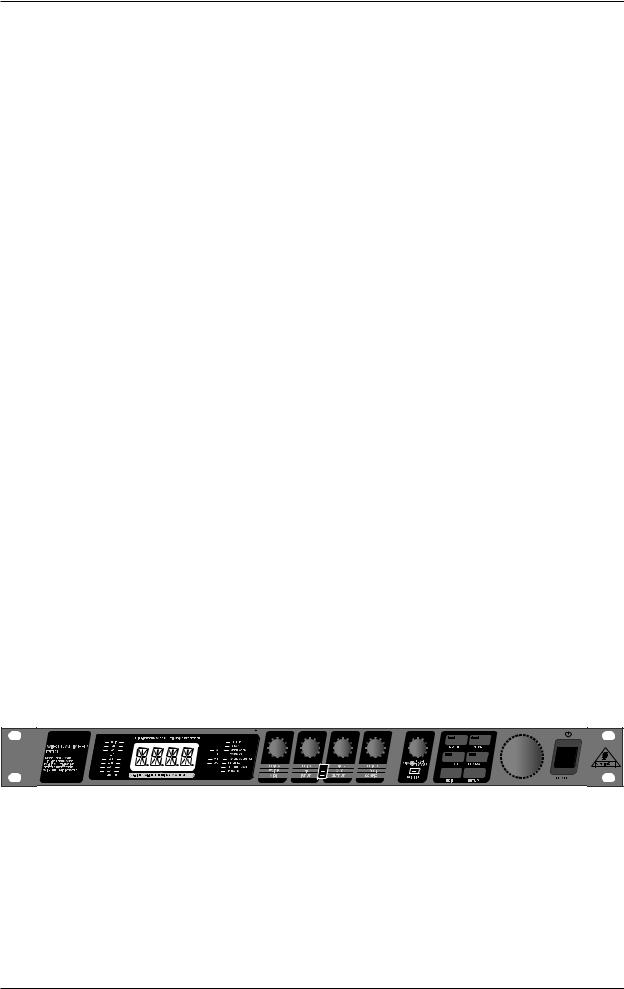
VIRTUALIZER PRO DSP2024P
1.2 Before you get started
The VIRTUALIZER PRO was carefully packed in the factory to ensure safe transport. Nevertheless, if the box shows signs of damage, please check the equipment immediately for any signs of external damage.
If the unit is damaged, please do not return it to BEHRINGER, but notify your dealer and the shipping company immediately. Otherwise, claims for damage or replacement may not be granted. Shipping claims must be made by the consignee.
The BEHRINGER VIRTUALIZER PRO requires one standard 19" rack unit of space (1 3/4"). Please leave an additional 4" installation depth to allow connections at the rear side.
Make sure that there is adequate ventilation and do not place the VIRTUALIZER PRO on top of an amplifier, which could cause overheating.
Before connecting the VIRTUALIZER PRO to the mains, carefully check that your equipment is set to the correct voltage:
The fuse holder on the female mains connector has 3 triangular markings, with two of these triangles opposing each other. The VIRTUALIZER PRO is set to the operating voltage printed next to these markers and can be set to another voltage by turning the fuse holder by 180°. CAUTION: This instruction does not apply to export models exclusively designed, e.g. for 115-V operation!
Connection to the mains is made by a mains cable with an IEC receptacle that complies with the required safety regulations.
All pieces of equipment must be grounded. For your own safety, under no circumstances should you remove or de-activate the grounding of your equipment or the mains cable.
Installation and operation of this equipment must be carried out by competent staff only. Both before and after installation, the staff using the equipment should make sure that it is properly grounded since otherwise electrostatic discharge etc. can lead to an impairment of its operation. For more information, see chapter 6 “INSTALLATION”.
The BEHRINGER VIRTUALIZER PRO is equipped with electronically servo-balanced inputs and outputs. The circuit design features automatic hum suppression for balanced signals and thus ensures trouble-free operation, even at the highest operating levels. Externally induced mains hum, etc. can therefore be effectively suppressed. The automatic servo-function recognizes the presence of unbalanced connectors and adjusts the nominal level internally to avoid level differences between the input and output signals (6-dB correction).
The MIDI connectors (IN/OUT/THRU) are standard DIN plug connections. The data communication is isolated from ground by opto-couplers.
1.3 Control elements
Fig. 1.1: VIRTUALIZER PRO front panel
The BEHRINGER VIRTUALIZER PRO’s front panel includes five edit controls (non-intermittent rotary controls), a jog wheel (big rotary control), six parameter keys, an LED display and a mains switch. Each of the two fully independent channels can be monitored with an 8-digit LED meter.
1. INTRODUCTION |
7 |
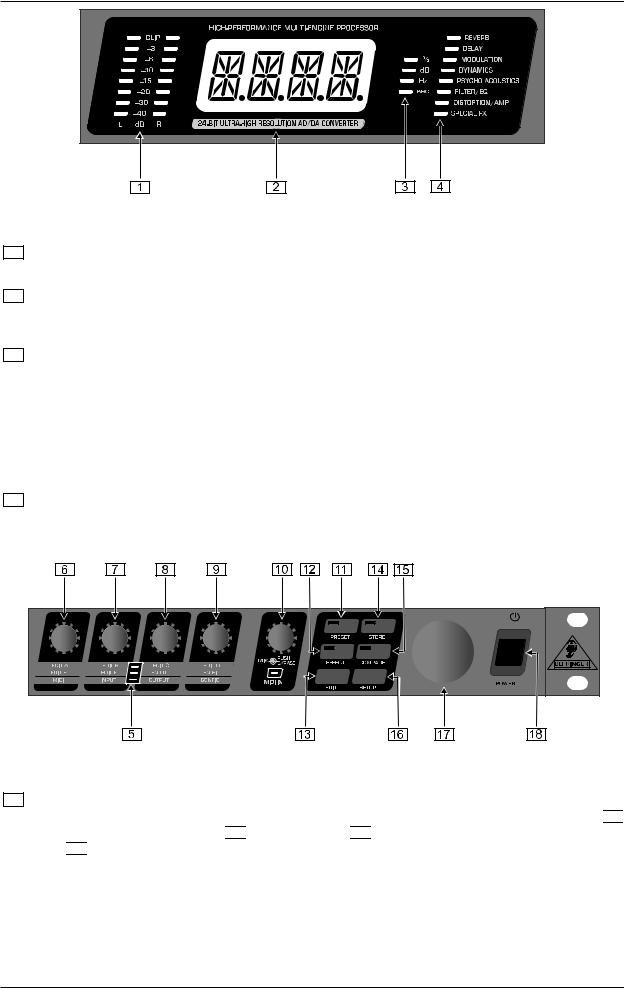
VIRTUALIZER PRO DSP2024P
Fig. 1.2: Display section of the VIRTUALIZER PRO
1Both the LED CHAINS display the intensity of the input signal in dB in relation to the nominal level, which is selected on the rear panel with the OPERATING LEVEL switch.
2After you switch on the VIRTUALIZER PRO, you can read the name of the last used effect on the LED DISPLAY. When editing, the LED DISPLAY shows the parameter’s name along with a 4-digit alpha-numeric display that shows the absolute parameter’s value.
3To the right of the LED DISPLAY are four STATUS LEDs which indicate the type of value you are working with. You may do any of the following:
set the absolute value of an effect parameter (“%”),
increase or decrease the amplitude or determine the threshold point of the compressor (“dB”), modify a frequency (“Hz”) or
modify a time parameter (“sec”).
4The ALGORITHM GROUPS LED CHAIN indicates which category the selected effect belongs to. Altogether the DSP2024P offers eight different algorithm groups.
Fig. 1.3: Function keys, controls and jog wheel
5Every preset in the DSP2024P allows you to edit at least four effect parameters. The EDIT-LED-CHAIN indicates which parameters are adjusted by the four EDIT CONTROLs. If the top LED lights up, 

 controls the parameter EDIT A,
controls the parameter EDIT A, 

 controls EDIT B,
controls EDIT B, 

 helps in changes of parameter EDIT C and with
helps in changes of parameter EDIT C and with 

 you change the setting of parameter EDIT D. If the middle LED of the EDIT-LED-CHAIN lights up, the four EDIT CONTROLs modify the parameters that are arranged to its left and right. The lower LED functions correspondingly.
you change the setting of parameter EDIT D. If the middle LED of the EDIT-LED-CHAIN lights up, the four EDIT CONTROLs modify the parameters that are arranged to its left and right. The lower LED functions correspondingly.
For the exact meaning of the individual effect parameters, see chapter 7.1.
8 |
1. INTRODUCTION |
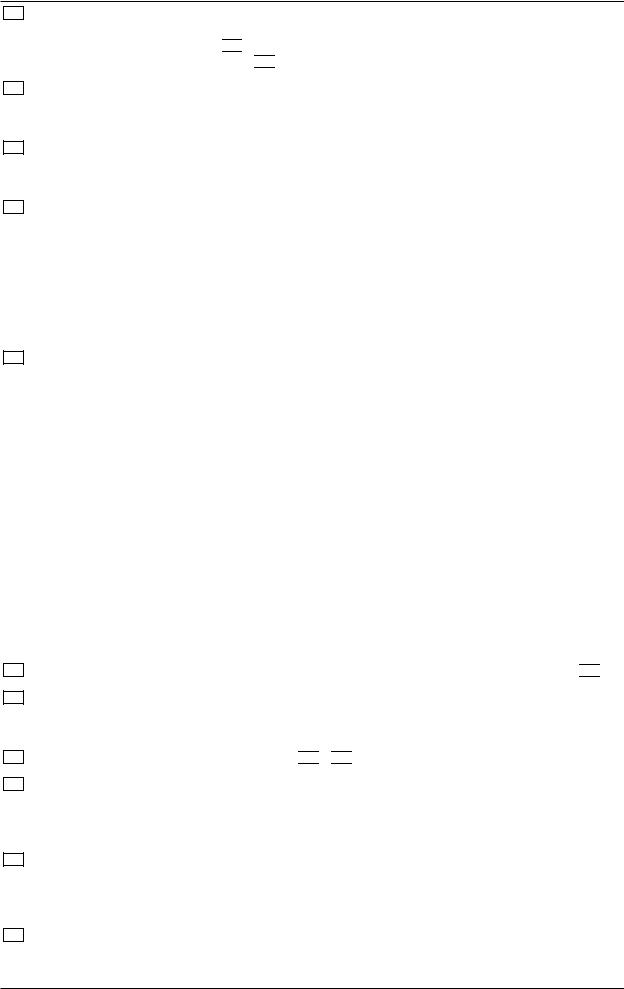
VIRTUALIZER PRO DSP2024P
6With the 1st EDIT CONTROL (non-intermittent rotary control) you change the values of the first (EDIT A)
and fifth (EDIT E) effect parameters. You can also select MIDI functions (MIDI) with the 1st EDIT CONTROL. Press the EDIT key 


 to switch from EDIT A to EDIT E and vice versa. You reach the MIDI function by pressing the SETUP key
to switch from EDIT A to EDIT E and vice versa. You reach the MIDI function by pressing the SETUP key 


 .
.
7The 2nd EDIT CONTROL allows you to modify the values of effect parameters EDIT B and EDIT F. When you select the INPUT parameter with the help of the SETUP key, you can specify whether the DSP2024P functions mono or stereo mode (see chapter 3.6.2 for more information).
8The 3rd EDIT CONTROL modifies the values of effect parameters EDIT C, EQ LO, and the global OUTPUT parameter (see chapter 3.6.3). Here, as well, you select among them using the EDIT and SETUP keys.
9With the 4th EDIT CONTROL, you modify the values of effect parameters EDIT D, EQ HI, and the global parameter CONFIG (see chapter 3.6.4). Use the EDIT and SETUP keys to choose between the parameters.
During editing, you can rotate one of the four EDIT CONTROLs minimally to display a brief description of the current parameter active. This can help you know that, for example, EDIT A controls the pre delay for all reverb effects of the VIRTUALIZER PRO. After approximately one second the name is erased and the parameter’s current value is displayed. This function can be used only by operating one of the controls that has not yet been selected.
10By turning the MIX/BYPASS CONTROL the effect levels of most effect algorithms are set in the range from 0 to 100%. If you select 0%, the signal at the inputs of DSP2024P is transferred directly to the outputs without adding any effects (the signal is completely dry). If you select 100%, only the effected signal is sent to the outputs (the signal is completely wet).
If you use the DSP2024P in the aux bus with your mixing console, you should always set this value at 100%. if you’re using the DSP2024P with a guitar amplifier (in a serial effects loop), we suggest settings between 20 and 50% (depending on the amplifier type).
Please note that, for the effects “parametric” and “graphic EQ”, the MIX/BYPASS CONTROL allows a gain correction by rotation.
To bypass the DSP2024P’s effects, press the MIX/BYPASS CONTROL. This allows you to compare between the original and the effected signals. Press the MIX/BYPASS CONTROL again to deactivate the bypass and return to your chosen effect. When the MIDI IN LED below the control flickers, it indicates that MIDI data is arriving at the MIDI IN port.
Both the MIX/BYPASS CONTROL and the four EDIT CONTROLs react dynamically. This means that, depending how fast you rotate the wheels, the present parameter is changed in steps of 1, 2, 5 or 10. The faster the rotation, the greater the change in the parameter value.
11To select one of the 200 presets, press the PRESET key once, then rotate the JOG WHEEL 


 .
.
12To select one of the 71 basic effect algorithms, press the EFFECT key once, then rotate the JOG WHEEL. For information on the parameter values that are set for the basic effect algorithms, see chapter 7.4.
13To select the EDIT CONTROL function (see 

 -
- 

 ), press the EDIT key.
), press the EDIT key.
14When you make changes to a user preset, the STORE key’s LED begins to blink. The DSP2024P comprises 100 user presets for your own settings and 100 factory presets (see separate preset sheet). To save your changes, press the STORE key. Select a storage space (number) with the JOG WHEEL and confirm it by pressing the STORE key again.
15If you have made changes to a preset and the LED of the STORE key is blinking, you can press the COMPARE key to temporarily restore the preset’s original settings. While these settings are loaded, the COMPARE key’s LED blinks and “COMP” appears in the LED DISPLAY. Press the COMPARE key again to return to edit mode and store your changes.
16To enter SETUP mode, press the SETUP key. In setup mode, you can access the parameters shown below the four EDIT CONTROLs. For more information about SETUP mode, see chapter 3.6.
1. INTRODUCTION |
9 |
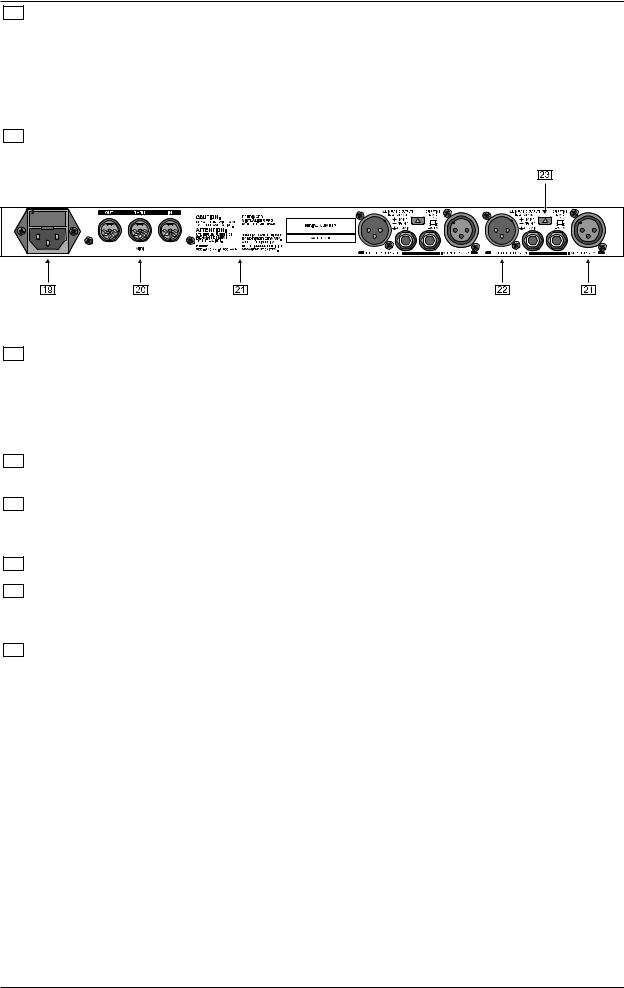
VIRTUALIZER PRO DSP2024P
17To change a parameter’s value, rotate the JOG WHEEL. To increase the value, turn the wheel clockwise. To decrease the value, turn the wheel counterclockwise. If none of the edit functions is selected, you can select a program directly with the JOG WHEEL. When you do so, a spot lights up in the LED DISPLAY. As long as the spot is illuminated, a program can be selected without making the corresponding settings immediately audible. This brief signal suppression means that during quick selection of presets with the JOG WHEEL, not every preset is activated directly. If the JOG WHEEL is not turned for a second, the spot in the LED DISPLAY disappears and the program is loaded.
18To turn the VIRTUALIZER PRO on and off, use the POWER switch.
Fig. 1.4: VIRTUALIZER PRO rear panel
19FUSE HOLDER / VOLTAGE SELECTION. Before connecting the DSP2024P, confirm that the voltage display matches your local mains voltage. When replacing the fuse, you must always use the same type. In many units the fuse holder can be installed in one of two positions, allowing you to switch between 230 V and 115 V. If you wish to operate a unit outside Europe at 115 V, then a stronger fuse must be used. (For more information, see chapter 8 “SPECIFICATIONS”). The mains connection is made via the IEC receptacle. An appropriate mains cable is included.
20The DSP2024P has wide-ranging MIDI implementation. MIDI IN, MIDI OUT, and MIDI THRU connectors are available for transmitting MIDI commands.
21SERIAL NUMBER. Please complete and return the warranty card within 14 days of the date of purchase. Otherwise, you will lose your right to the extended warranty. Alternatively, you can register online at our website under www.behringer.com.
22The DSP2024P’s balanced OUTPUTs are designed as 1/4" TRS and XLR sockets.
23To switch between -10 dBV (home recording level) and +4 dBu (professional studio level), use the OPERATING LEVEL SWITCH. When you switch between the two, the level displays are automatically changed to the nominal level and the VIRTUALIZER PRO operates in its optimal working range.
24Both of the VIRTUALIZER PRO’s INPUTs are also available as balanced 1/4" TRS and XLR sockets.
2.EFFECTS ALGORITHMS
All effects of digital effects equipment are based on various algorithms. An algorithm for a reverb effect, for example, is programmed differently than a chorus algorithm. Each effect has a certain algorithm with which the digital input signal is processed. The processing takes place within the digital signal processor (DSP). After the effect is generated and the input signal is mixed, the digital signal is converted back into an analog signal with a D/A converter.
You can edit up to seven parameters for each preset in the VIRTUALIZER PRO. The changes you make will influence the sound in different ways. An overview of the DSP2024P’s various effects algorithms follows.
10 |
2. EFFECTS ALGORITHMS |
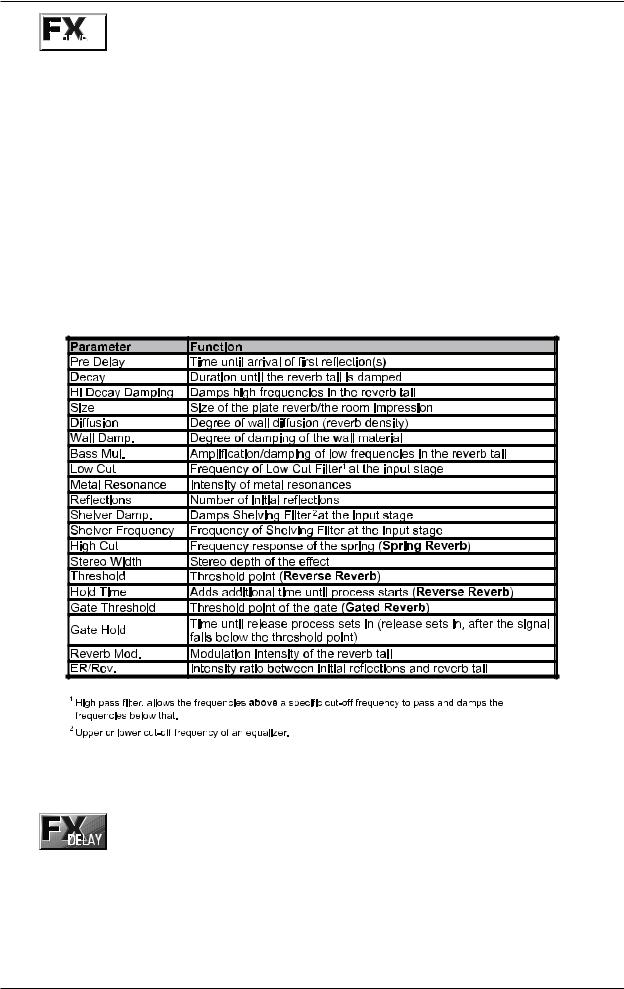
VIRTUALIZER PRO DSP2024P
2.1 Reverb algorithms
REVERB: As the term suggests, a “reverb” is a reverberation effect. The reverb can be considered as the most important effect in a mix-down or a live event. The DSP2024P offers 12 different reverberation programs so that you have a suitable reverb for every situation. Cathedral simulates the dense, long reverberation of a large cathedral, which is appropriate for solo instruments or vocals in slow pieces. Gold Plate simulates the sound of plate reverberators and hence is a classic for drums (snare) and vocals. Small Hall simulates a small, lively (strongly reflecting) hall. With Room, you can clearly hear the walls of the room. Studio represents a smallto middle-sized room. With Concert, you can select between a small theater and a large hall. Stage is well suited to dissipating the sound of a keyboard or an acoustic guitar. Spring Reverb simulates a classic spring reverberation. Ambience reproduces a room impression without late reflections. With Early Reflections, the initial reflections of a room are clearly audible.
GATED REVERB: This effect synthetically cuts off reverberation after a period of time. It is famous in the song “In the Air Tonight” by Phil Collins.
REVERSE REVERB: This is a reverberation in which the envelope is reversed—it slowly gets louder.
Tab. 2.1: Functioning of the reverb effects’ parameters
2.2 Delay algorithms
STEREO DELAY: A delay of the input signal. Different tempo settings allow interesting delay effects.
TAPE ECHO: Similar to the stereo delay, with the difference being that the repetitions have less presence. This simulates the character of the original tape echo that was used before the digital era and can be thought of as a “Vintage Sound”. The tape echo’s reflections include high and low pass filters.
2. EFFECTS ALGORITHMS |
11 |
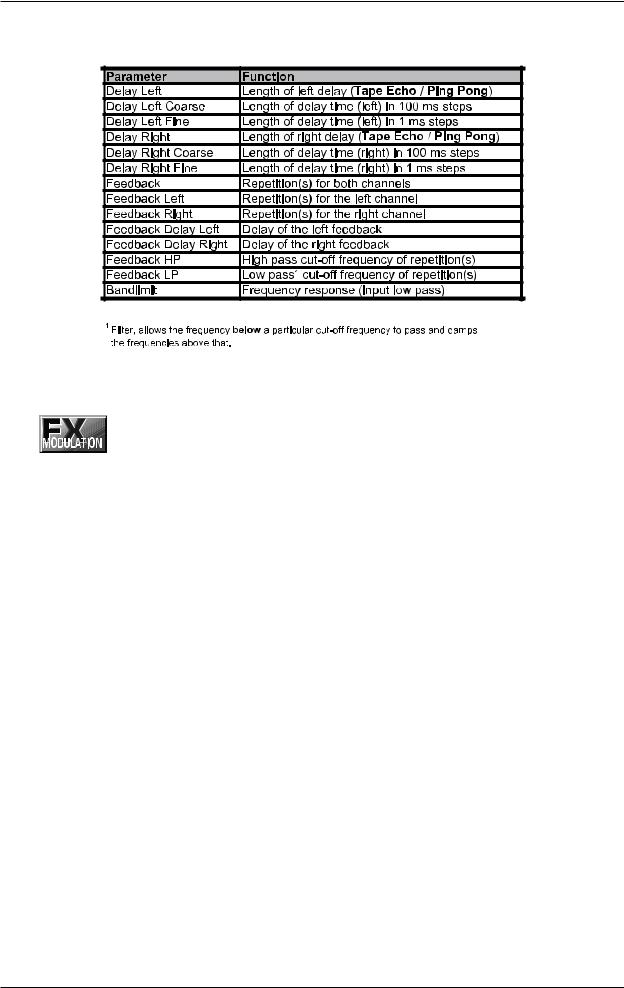
VIRTUALIZER PRO DSP2024P
PING PONG: A delay effect with changing stereo positioning, where the time intervals between the repetitions can be changed.
Tab. 2.2: Functioning of the delay effects’ parameters
2.3 Modulation and Pitch Shifter effects
FLANGER: The word “flange” means “tape spool”, and this explains the characteristics of the effect. Originally the flanger effect was generated with two tape recorders which ran synchronously. The same audio signal was recorded on both machines. If you put a finger on the left spool of one of the machines, the spool and the playback speed are slowed down. The generated delay results in phase shifting of the signals. Vintage Flanger simulates a guitar flanger effect pedal and Jet Stream Flanger sounds like a classic analog flanger.
CHORUS: This effect slightly detunes the original signal. A very pleasant detune effect is created in connection with the pitch variation. The chorus effect is quite often and extensively used for dispersing signals. Analog Chorus simulates a guitar chorus effect pedal, while Vintage Chorus imitates a classic analog studio chorus. Ultra Chorus creates the sound of an eight-person vocal chorus.
PHASER: With the phaser, a second, phase shifted signal is added to the original audio signal. The resulting sound is thicker and above all livelier. This effect is often used for guitar sounds and keyboards. In the 70s, it was also extensively used for other instruments like electric pianos. Here, Vintage Phaser represents a guitar phaser effect pedal. Dual Phaser processes the left and the right channels separately.
ROTARY: The simulation of a classic effect that is normally generated with a very heavy enclosure with a (slow or fast) rotating speaker: The bass speaker (drum) is covered by a partly opened rotating cap, while both of the high pitch horns (horn), displaced by 180°, revolve around the same perpendicular axis. Here, the physical principle of the Doppler effect for modulation of signals is used.
PITCH SHIFTER: This effect changes the pitch of the input signal. You can generate musical intervals and harmonies or simply a single voice. Detuning by several semitones upward alienates voices (and is used often in cartoons). Here, you can choose among a stereo, two, and three vocal pitch shifter. At the left stop of Edit C the pitch shifters 1 and 2 are synchronized to a stereo pitch shifter. Pitch shifter 3 can be switched off by turning Edit E fully counterclockwise.
VIBRATO: For this effect, the peak frequency of a tone is periodically and uniformly changed (quickly or slowly). It is often used for guitar playing.
TREMOLO: This effect was originally found on guitar amplifiers, and is once again trendy. It is a fast or slow periodic variation of the volume.
12 |
2. EFFECTS ALGORITHMS |
